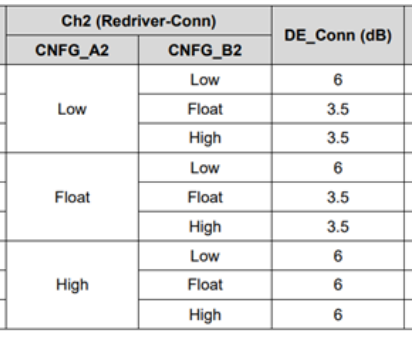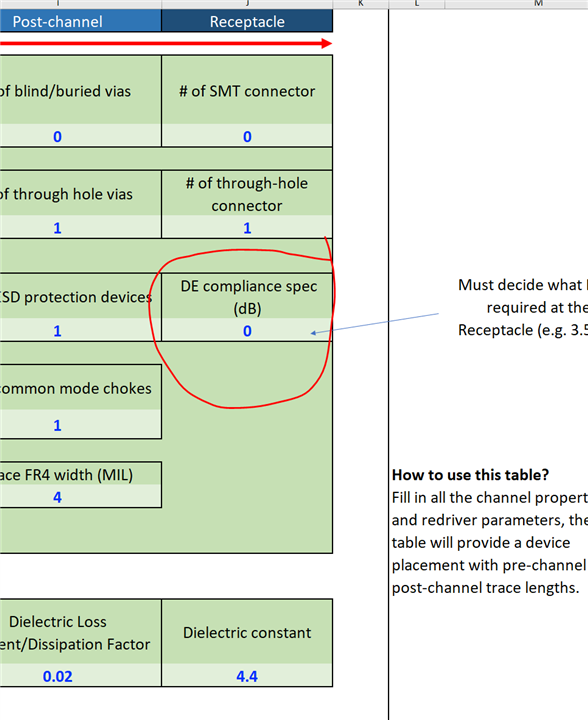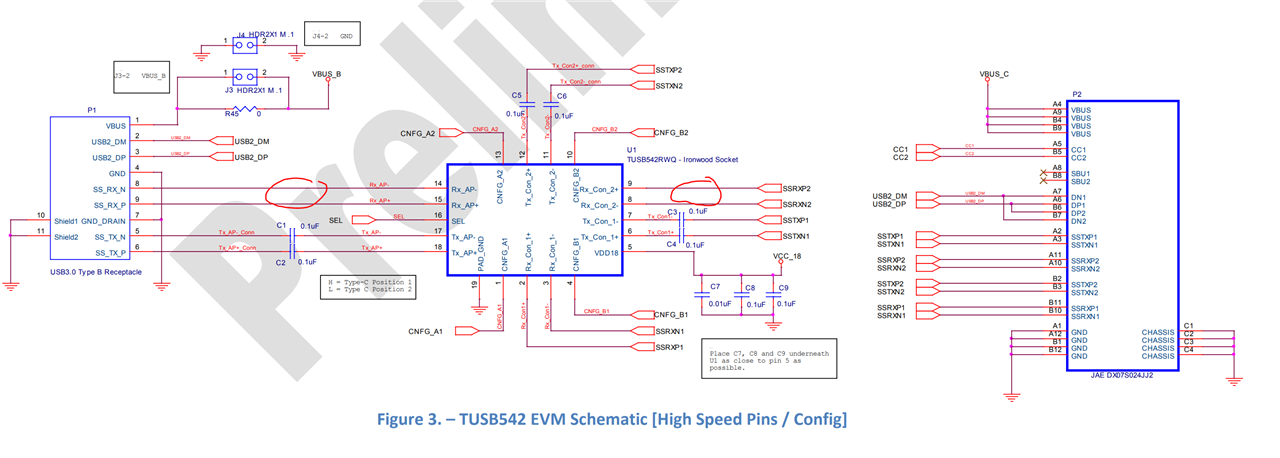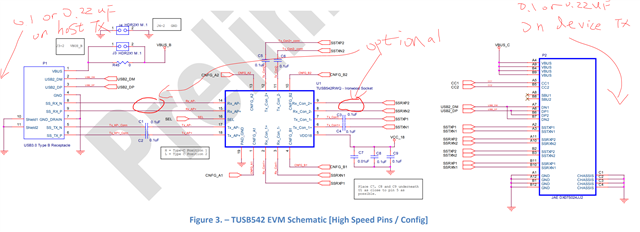Hi team,
I know linear redriver tends to be placed to connector as close as possible.
but looks like TUSB542 is limited one (DE is always >0),
so is there a distance limit between connector and redriver to prevent over-compensation.

This thread has been locked.
If you have a related question, please click the "Ask a related question" button in the top right corner. The newly created question will be automatically linked to this question.
Hi team,
I know linear redriver tends to be placed to connector as close as possible.
but looks like TUSB542 is limited one (DE is always >0),
so is there a distance limit between connector and redriver to prevent over-compensation.

Hi,
The De-emphasis setting must be set based on the length and characteristics of the post channel (channel after the TUSB542 device). And the corresponding RX will then adjust its EQ to compensate for the remaining loss as part of the USB link training.
Thanks
David
Hi David,
let's say compliance short-channel test which means basically not cable condition, and the pre-channel loss is well-compensated.
if we place it very close to connector, it might potentially get over-compensated( since we don't have 0dB DE option)
so in that case, can we decrease the AP_EQ to prevent it or we just place it not too close to connector?

Hi,
You can use the spreadsheet to calculate the trace length between TUSB542 and the connector, but I would agree with you that you do not want to put TUSB542 next to the connector.
Thanks
David
Hi David,
just want to check with you that this DE spec at TX budget,
does this mean it's the DE dB power that required by the other side of connector,
so for short channel case as example, I should input 0dB since there's no cable loss(no need for compensation) expected at connector side, right?
but what if long channel compliance , what should I input for long channel compliance scenario?

Hi,
does this mean it's the DE dB power that required by the other side of connector,
*** Correct, the is the DE that is required by the device. So we took the max DE the TUSB542 can support, subtract the PCB parasitic loss, subtract the required DE to come up with how much DE margin we have left (Max TUSB542 DE - Parasitic loss - required DE).
so for short channel case as example, I should input 0dB since there's no cable loss(no need for compensation) expected at connector side, right?
*** No, remember the device can adjust its EQ during link training. So for short channel case, it will reduce its EQ. For long channel case, it will increase the EQ if the TX DE (in this example, 3.5dB) is not enough.
Thanks
David
Hi David,
thanks for your explanation yesterday,
all this question actually is because
I was worried about over-compensated(DE too strong) in short channel case even device side tune its EQ to completely 0 already,
but judging from our discussion yesterday, looks like in practical case it's actually quite hard to failed the eye diagram with the whole channel being over-compensated ,
am I right?
Hi,
It depends on how much the signal is over-compensated. The eye will not be fully closed if there is a little over-compensation.
Thanks
David
Hi,
Is this between the source and TUSB542 or between TUSB542 and the USB connector?
For between the source and TUSB542, the capacitor must be placed and value is between 75nF to 265nF.
For between TUSB542 and the USB connector, the capacitor is optional and value must be 330nF or 470nF.
Thanks
David
hi David,
this photo was modified by EVM,
you mention :For RX cap between the source and TUSB542, the capacitor "must" be placed and value is between 75nF to 265nF.
but there's no cap on that side at EVM,
so I'm curious why the cap value is out of spec?

Hi,
Please see this block diagram below, let me know if you want to talk over the phone for further clarification.

Thanks
David
Hi David,
I kind of understand it,
if CPU TX already has 0.1uF , then RX_AP cap will be optional and dummy, but if they still place it , it need to be 330nF or 470nF
you can pass the answer if I'm right,
thanks
HI,
This is correct. And with 100nF on the TX side, and optional 330nF or 470nF on the RX side, the total capacitance will still meet the USB spec of 75nF-265nF requirement.
Thanks
David